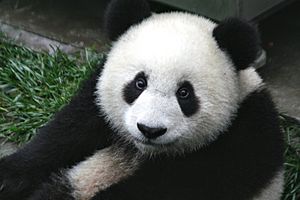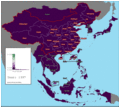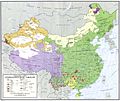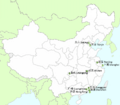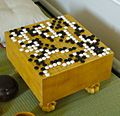People's Republic of China facts for kids
Quick facts for kids
People's Republic of China
|
|
|---|---|
|
|
|
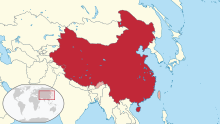
Official area of the People's Republic of China shown in dark red; area claimed but disputed shown in light red.
|
|
| Capital | Beijing |
| Largest city | Shanghai |
| Official languages | Standard Chinese (or Putonghua) |
| Recognised regional languages | Mongolian, Tibetan, Uyghur, Zhuang and various others |
|
Official written language
|
Chinese |
|
Official script
|
Simplified Chinese |
| Ethnic groups | 91.51% Han; 55 recognised minorities |
| Religion | State Atheism |
| Demonym(s) | Chinese |
| Government | Unitary socialist one-party state |
|
• CCP General Secretary (and President)
|
Xi Jinping |
|
• Premier
|
Li Keqiang |
| Li Zhanshu | |
| Legislature | National People's Congress |
| Establishment | |
|
• Unification of China under the Qin Dynasty
|
221 BC |
| 1 January 1912 | |
| 1 October 1949 | |
| Area | |
|
• Total
|
9,640,821 km2 (3,722,342 sq mi)or 9,671,018 km² (3rd/4th) |
|
• Water (%)
|
2.8 |
| Population | |
|
• 2010 census
|
1,339,724,852 (1st) |
|
• Density
|
139.6/km2 (361.6/sq mi) (83rd) |
| GDP (PPP) | 2019 estimate |
|
• Total
|
$27.449 trillion (1st) |
|
• Per capita
|
$19,559 (79rd) |
| GDP (nominal) | 2019 estimate |
|
• Total
|
$15.543 trillion (IMF) $15.224 trillion (China NBS) (2nd) |
|
• Per capita
|
$11,074 (70th) |
| Gini (2015) | 46.2 high |
| HDI (2017) | high · 86st |
| Currency | Renminbi (yuan) (¥) (CNY) |
| Time zone | UTC+8 (China Standard Time) |
| Date format | yyyy-mm-dd or yyyy年m月d日 (CE; CE-1949) |
| Driving side | right, except for Hong Kong & Macau |
| Calling code | +86 |
| ISO 3166 code | CN |
| Internet TLD | .cn .中國 .中国 |
|
a. Simple descriptions of the political structure since the 1980s are no longer possible.
b. 9,598,086 km2 (3,705,842 sq mi) excludes all disputed territories. |
|
The People's Republic of China (PRC) (simplified Chinese: 中华人民共和国; traditional Chinese: 中華人民共和國) is a country in East Asia. It is ruled by the Chinese Communist Party (CCP). The PRC was started on October 1, 1949. It has more than 1.4 billion people, which is more than any other country in the world. China covers a huge area of 9.6 million square kilometers.
Beijing is the capital city. Shanghai is the city with the most people living in it. Beijing, Shanghai, Tianjin, and Chongqing are special "municipalities." This means they are directly controlled by the national government.
Two other cities are called "special administrative regions" (SARs). These are Hong Kong and Macau. Hong Kong used to be a colony of the United Kingdom and was returned to China in 1997. Portugal returned Macau in 1999. These two cities have a lot of their own power and laws.
Besides these special cities, China has 23 provinces. It also has five "autonomous regions." These regions have more rights to make their own laws. Many people from minority groups live in these areas. Some of these regions are Xinjiang Uyghur Autonomous Region and Tibet Autonomous Region.
In the SARs, the main government handles defense and foreign affairs. But it does not control daily operations for 50 years. The PRC says that Taiwan is one of its provinces. However, the PRC does not control Taiwan. Taiwan has a different political system. It is officially known as the Republic of China (Taiwan).
Contents
China's Long History
China has one of the world's oldest civilizations. It is also the oldest civilization that has continued without stopping. There is archaeological proof that it is over 5,000 years old. China also has one of the oldest writing systems in the world. It is the oldest one still used today. Many important inventions came from China.
Ancient Times (2100 BC - 1500 AD)
Ancient China was one of the first civilizations. It was active as a feudal society since the 2nd millennium BC.
Chinese civilization was one of the few to invent writing. Other places that did this include Mesopotamia and Ancient Egypt. China reached its best time during the Tang Dynasty (around 10th century AD). Ideas like Confucianism and Daoism started here. These ideas greatly influenced nearby countries like Japan, Korea, and Vietnam. This influence covered their governments, beliefs, art, and even writing. China is home to some of the oldest artwork, like statues and pottery.
Before the Qin Dynasty united China, many small states fought each other. This period was called the Warring States Period. Even though there was much suffering, many great philosophies were born then. These include Confucianism and Daoism. These ideas are still important in many East Asian cultures today.
Ancient China's land was mostly like modern China. But its northern and western borders changed often. It was often attacked by northern nomadic people like the Turkic tribes and the Mongols. Famous Mongol leaders were Genghis Khan and Kublai Khan. When northern people ruled China, they often adopted Chinese ways of life. They also brought new parts to Chinese culture.
A New Era Begins
China achieved many great things in the first and early second millenniums. But it became an isolationist country in the 15th century. This meant it cut itself off from the rest of the world.
By the time of the Renaissance, European countries started taking over other parts of Asia. During this time, a problem with opium grew in China. Foreign traders, mainly British, illegally brought opium from India to China. This trade grew a lot from about 1820. Many people in China became addicted. This caused big social and money problems.
This led to the first Opium War between China and Great Britain. It lasted from 1839 to 1842. Britain used its strong military to force China to open its markets. They also forced the trade of opium on the Chinese people.
China was never fully taken over by Europeans. But many European countries, like Britain and France, gained influence there. China had fallen behind in technology because it had been isolated. So, it could not stop this from happening. This was clear when China lost the Opium Wars to Britain in the 19th century.
In 1912, the Qing dynasty was overthrown. Sun Yat-sen and the Kuomintang, a nationalist party, started the Republic of China. Over time, Marxist ideas became popular. This led to the creation of the Communist party.
The Chinese Civil War started between the Nationalists (Kuomintang) and the Communists. The Communists wanted China to be like the Soviet Union. The Nationalists wanted to keep China as it was. Mao Zedong led the Communists. The Communists eventually won the war. The Nationalists, led by Chiang Kai-shek, went to the island of Taiwan. They set up their capital in Taipei.
After the Chinese Civil War, Mao Zedong declared a new country. It was called the People's Republic of China (PRC). This happened in Beijing on October 1, 1949.
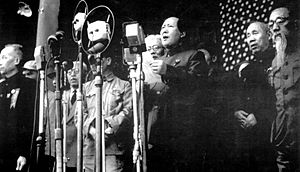
As the leader of the Chinese Communist Party, Mao started many big changes. These changes aimed to improve society and the economy. But they had mixed results. The Great Leap Forward, from 1958 to 1961, tried to make China an industrial country. It also tried to grow more food. But it caused one of the biggest famines in history. About 45 million people died.
In 1966, Mao started the Cultural Revolution. This was to remove capitalist ideas from society and government. Many officials and citizens were accused of disagreeing with Marxism. They were persecuted. Many schools were closed. Historical and religious places were destroyed. The program officially ended in 1969. But it continued until Mao's death in 1976.
During this time, the People's Republic of China did not get along with capitalist countries. Also, relations with the Soviet Union became unfriendly in the Sino-Soviet Split. In 1972, to balance the Soviet Union's power, Mao met with US President Richard Nixon. This helped improve China's relationships with Western countries.
After Mao died, Deng Xiaoping took power. He started a "Reform and Opening Up" campaign. These reforms aimed to make China a modern, industrial nation. It would still be socialist but move towards a market system. Deng's policies were called "socialism with Chinese characteristics."
Deng's policies gave citizens more freedom. However, the government still controls many parts of people's lives. In 1979, the one-child policy was created. This policy limited most couples to one child. It was made because of overpopulation in China. This policy was very controversial. Many Westerners criticized it. News and Internet sites are also censored by the government.
In 1989, the Chinese Communist Party used soldiers and tanks. They stopped a protest in Beijing's Tiananmen Square. Students organized it to ask for political changes. This action was criticized worldwide. It led to economic sanctions against the Chinese government.
In August 2008, China hosted the Summer Olympics for the first time.
China's Geography
The People's Republic of China is one of the largest countries in the world. It is usually ranked third or fourth in size. It is the second-largest by land area. China has almost every kind of climate found in the northern hemisphere. It borders 14 nations, which is more than any other country. These include Vietnam, India, Mongolia, and North Korea.
China has two major rivers: the Yellow River and the Yangtze River. It also has large deserts like the Taklamakan and the Gobi Desert.
The world's highest point, Mt. Everest (8848m), is on the border between China and Nepal. The country's lowest point is Ayding Lake (−154m). It is the world's fourth-lowest point.
Amazing Animals and Plants
China is one of 17 "megadiverse countries." This means it has a huge variety of plants and animals. It is part of two major ecozones: the Palearctic and the Indomalaya. In the Palearctic zone, you can find animals like horses, camels, and jerboas. In the Indomalaya region, there are Leopard Cats, bamboo rats, and many types of monkeys. Some animals, like deer, bears, and wolves, live in both regions. The famous giant panda lives only in a small area along the Yangtze River. China is working to stop the illegal trade of endangered species.
China also has many types of forests. Cold coniferous forests cover most of the north. These forests are home to animals like moose and the Asian black bear. They also have over 120 bird species. Moist conifer forests can have thick bamboo areas. Subtropical forests are mostly in central and southern China. They have as many as 146,000 types of plants. Tropical rainforests are found in Yunnan and Hainan Island. They have a quarter of all the plant and animal species in China.
China's Government
China is a one-party state. This means one political party, the Chinese Communist Party (CCP), holds all the power. The General Secretary of the CCP is the most powerful leader. The current General Secretary is Xi Jinping. He took office in 2012.
The President is the country's official head of state. The National People's Congress elects the President. Xi Jinping is also the current President. He is also the head of the military. This makes him China's most important leader.
The Premier is the head of government. The Premier leads the State Council. The current Premier is Li Keqiang.
China's Military
The Chinese Armed Forces are called the People's Liberation Army (PLA). It is one of the most powerful armies in the world. China is also one of the countries that has atomic weapons. It has the largest standing army in the world. Over 2 million soldiers are on active duty.
People and Culture
There are 56 recognized ethnic minority groups in China. The Han are the largest ethnic group. Mandarin Chinese is the main spoken language.
China is where Eastern martial arts began. These are called Kung Fu or Wushu. China is also home to famous places like the Spa Monastery and Wudang Mountains. Martial arts first started for survival, defense, and fighting. Over time, some forms became more like art. Others kept their unique Chinese style.
China has many famous artists. Art often uses a variety of paints.
China has many traditional festivals. These include the Chinese New Year, Dragon Boat Festival, and Mid-Autumn Festival. The most important is Chinese New Year. Another big holiday is the National Day in October.
Fun Festivals
Chinese New Year lasts for fifteen days. One week of this is a national holiday. It starts on the first day of the Chinese lunar year. It ends with the full moon fifteen days later. It is in the middle of winter. But it is called the Spring Festival in Chinese. On the first day, people visit friends and family. Many people stay up late on New Year's Eve to watch TV shows. So, they usually wake up later the next day.
The fifth day of Chinese New Year is for welcoming the god of Wealth. Many people make and eat dumplings (Chinese:饺子). They believe dumplings bring good luck. The last day of Chinese New Year is the Lantern Festival. On this day, the moon is full. People go out to see lantern displays everywhere. After that, they eat sweet dumplings (Chinese:汤圆,元宵). These dumplings are round, like the full moon.
The Dragon Boat Festival celebrates the death of Qu Yuan. He was a patriotic poet from the Warring States period. He tried to tell his emperor not to trust offers from another state. But the emperor did not listen. Qu Yuan was very sad and jumped into a river. People loved him. They did not want fish to eat his body. So, they made and threw rice dumplings into the river. They hoped the fish would eat the dumplings instead. They also raced dragon boats in the river to scare away the fish. Today, people eat rice dumplings and hold dragon boat races during this festival.
The Mid-Autumn Festival is a family festival. It is held on the fifteenth day of the eighth lunar month. Families gather to eat moon cakes and admire the moon. They celebrate a good harvest. They enjoy family love and happiness. For Chinese people, the full moon means family reunion. Moon cakes also symbolize this. That is why the Mid-Autumn Festival is also called the Family Reunion Festival.
Getting Around China
Trains are often used for long trips in China. Bullet trains are faster and very common in cities. China has more high-speed trains than any other country. Buses and air transport are also widely used.
Related pages
- List of provinces of China
- Political problems of China
- (English) Information, Links, History and more of China
- (English) China Maps
Images for kids
-
Yinxu, the ruins of the capital of the late Shang dynasty (14th century BCE)
-
China's first emperor, Qin Shi Huang, is famed for having united the Warring States' walls to form the Great Wall of China. Most of the present structure, however, dates to the Ming dynasty.
-
Map showing the expansion of Han dynasty in the 2nd century BC
-
A detail from Along the River During the Qingming Festival, a 12th-century painting showing everyday life in the Song dynasty's capital, Bianjing (present-day Kaifeng)
-
The Eight-Nation Alliance invaded China to defeat the anti-foreign Boxers and their Qing backers. The image shows a celebration ceremony inside the Chinese imperial palace, the Forbidden City after the signing of the Boxer Protocol in 1901.
-
Chiang Kai-shek and Mao Zedong toasting together in 1945 following the end of World War II
-
Mao Zedong proclaiming the establishment of the PRC in 1949.
-
A giant panda, China's most famous endangered and endemic species, at the Chengdu Research Base of Giant Panda Breeding in Sichuan
-
The Three Gorges Dam is the largest hydroelectric dam in the world.
-
Chengdu J-20 5th generation stealth fighter
-
China and other major developing economies by GDP per capita at purchasing-power parity, 1990–2013. The rapid economic growth of China (blue) is readily apparent.
-
China's nominal GDP trend from 1952 to 2015
-
Earliest known written formula for gunpowder, from the Wujing Zongyao of 1044 CE
-
Huawei headquarters in Shenzhen. Huawei is the world's largest telecoms-equipment-maker and the second-largest manufacturer of smartphones in the world.
-
Long March 2F launching Shenzhou spacecraft. China is one of the only three countries with independent human spaceflight capability.
-
Internet penetration rates in China in the context of East Asia and Southeast Asia, 1995–2012
-
The Duge Bridge is the highest bridge in the world.
-
Lihaozhai High School in Jianshui, Yunnan. The sign is in Hani (Latin alphabet), Nisu (Yi script), and Chinese.
-
Beijing's Peking University, one of the top-ranked universities in China
-
Geographic distribution of religions in China. ■ Chinese folk religion (including Confucianism, Taoism, and groups of Chinese Buddhism) ■ Buddhism tout court ■ Islam ■ Ethnic minorities' indigenous religions ■ Mongolian folk religion ■ Northeast China folk religion influenced by Tungus and Manchu shamanism; widespread Shanrendao
-
The stories in Journey to the West are common themes in Peking opera.
-
Go is an abstract strategy board game for two players, in which the aim is to surround more territory than the opponent and was invented in China more than 2,500 years ago.
See also
 In Spanish: República Popular China para niños
In Spanish: República Popular China para niños




